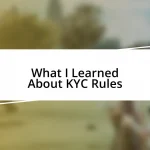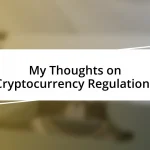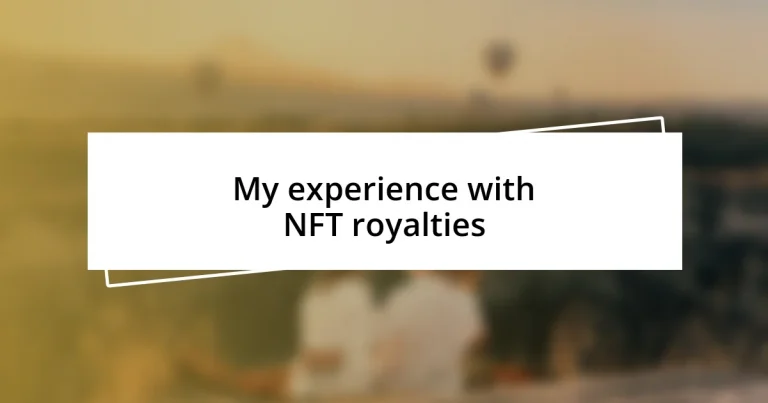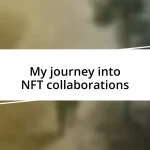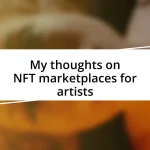Key takeaways:
- NFT royalties empower artists by allowing them to earn from resales, shaping a new paradigm of ownership and valuation in the digital art space.
- Challenges include inconsistent royalty enforcement across platforms, lack of transparency in payments, and tensions between artists and collectors regarding royalty negotiations.
- The future of NFT royalties may involve standardized practices, programmable royalties for automatic benefits, and a broader recognition of royalties as validation of artistic work.
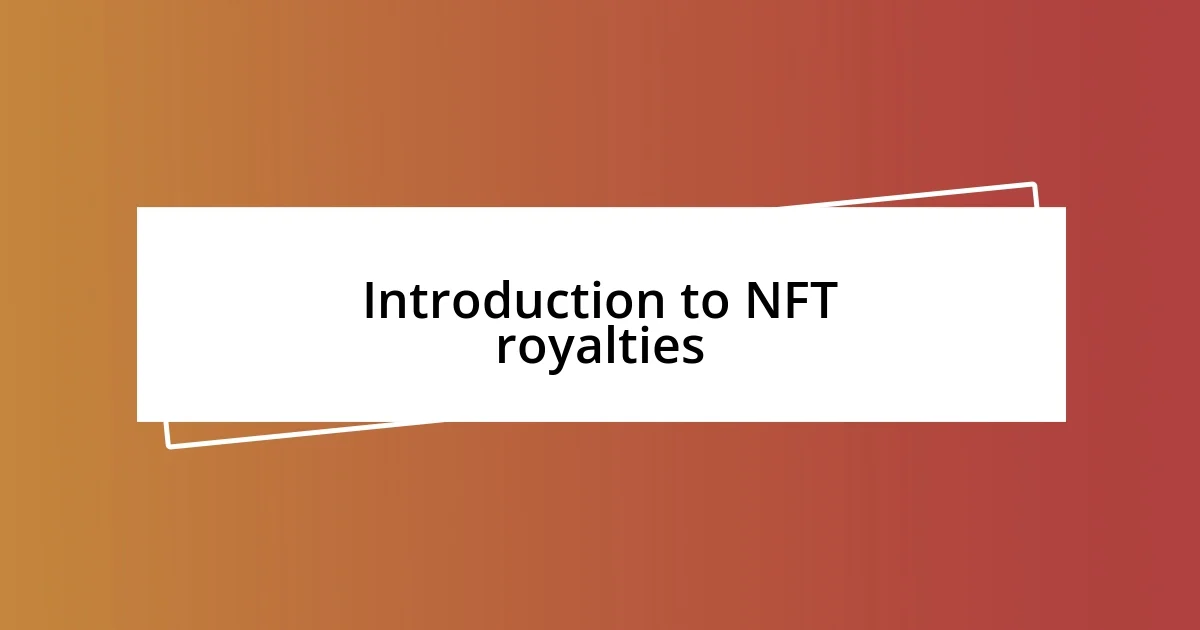
Introduction to NFT royalties
NFT royalties are a fascinating aspect of the digital art revolution, enabling creators to earn from their work beyond the initial sale. I remember excitement bubbling in the community when I first encountered the concept: artists could receive percentages from future sales, essentially creating a continuous revenue stream. Isn’t it incredible to think that an artist can benefit financially as their work gains value over time?
When I decided to dive into creating NFTs, understanding royalties was crucial for me. It felt liberating knowing that, every time someone re-sold my art, I would still receive a piece of that transaction. This concept really sparked a shift in how creators view ownership and valuation in the art world. Have you ever thought about how empowering that could be for artists who often struggle with the traditional market?
As NFT marketplaces continue to evolve, the structure of royalty percentages can vary widely. I’ve seen some platforms standardize them at 10%, while others allow for negotiation, leading to a rich diversity of agreements. This variability made me ponder: how might this flexibility affect the long-term relationships between artists and collectors? Understanding royalty structures can truly shape an artist’s success in the digital marketplace, and that’s an exciting journey to explore.
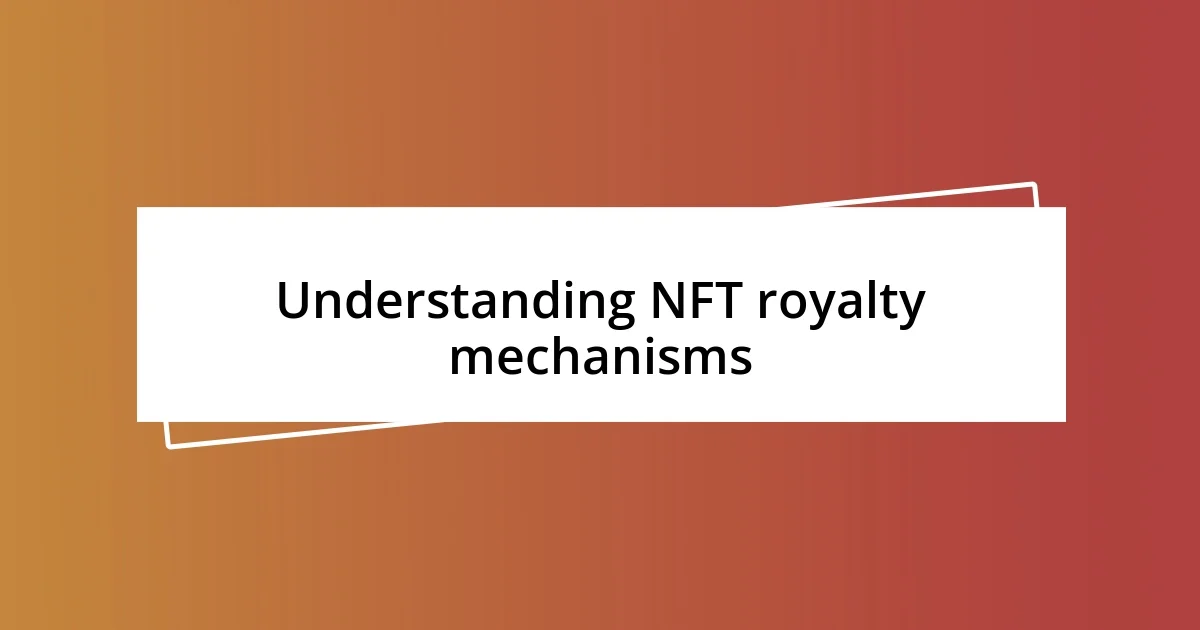
Understanding NFT royalty mechanisms
As I explored NFT royalties, I found it essential to grasp how these mechanisms operate. Every sale can include a percentage allocated to the original creator, which can be programmed into the smart contract that governs the NFT. I experienced firsthand the impact of this design; I was delighted to see a small but significant royalty from my own work when it resold, reinforcing my connection with my art and those who appreciate it.
Here are a few key points to illustrate how NFT royalty mechanisms work:
- Smart Contracts: These self-executing contracts ensure royalties are automatically distributed upon resale.
- Percentage Variability: Royalties can range from 5% to 15%, depending on the platform and agreement.
- Marketplaces: Each marketplace has different policies, which can influence how royalties are handled.
- Liquidity Events: As NFTs can change hands frequently, the potential for ongoing revenue can create financial security for artists.
- Community Engagement: Artists can cultivate deeper relationships with collectors, emphasizing shared success and mutual benefit.
I remember feeling a rush when realizing how each subsequent sale translated to tangible support—not just financially, but also as a validation of my creative journey. This ongoing relationship reshaped my understanding of art and commerce; I now see my work not just as a solitary piece, but as part of a larger narrative where I have a stake in its future.
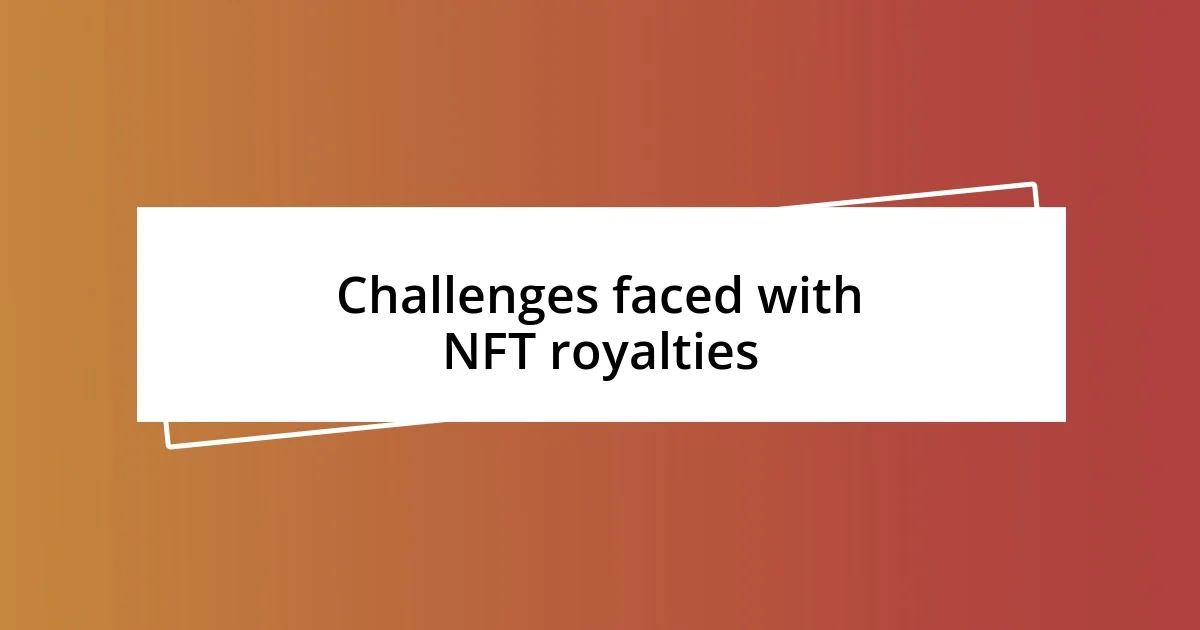
Challenges faced with NFT royalties
Navigating the NFT royalty landscape isn’t without its bumps. One major challenge I encountered firsthand was the inconsistency in royalty enforcement across different marketplaces. While one platform might honor the predetermined royalty percentage, another could completely overlook it, leaving creators like me at a disadvantage. It’s frustrating to think that while I’m building a sustainable income, there’s a possibility that some of my hard work won’t be rewarded. Have you ever felt the uncertainty of relying on differing rules in a marketplace? It can really be a gamble.
Another hurdle is the lack of transparency surrounding royalty payments. When I first got into NFTs, I naively assumed that I would receive my royalties promptly. However, I learned the hard way that delays and discrepancies in payment can occur, primarily due to the complexity of smart contracts and marketplace protocols. I vividly recall checking my wallet eagerly, only to find that a significant sum was missing due to an oversight in the contract details. This taught me a valuable lesson about the importance of understanding the fine print and actively monitoring sales.
Lastly, there’s the debate around collectors’ and artists’ perspectives on royalties. Some collectors feel a sense of entitlement to negotiate lower royalties to maximize their profits, which can create tension. Personally, I believe artists deserve fair compensation for their work, especially as the value of their art appreciates. I remember discussing this topic passionately with fellow creators, and it was clear that many of us feel strongly about maintaining artist royalties as vital to our community’s integrity. Who wouldn’t want to protect the hard-earned benefits of creative labor?
| Challenge | Description |
|---|---|
| Inconsistent Enforcement | Royalty percentages may be honored on some platforms but ignored on others, putting creators at a disadvantage. |
| Lack of Transparency | Delays and discrepancies in royalty payments can occur, primarily due to complex smart contracts. |
| Collector Negotiation | Some collectors seek to negotiate lower royalties, leading to tensions between artists and collectors. |
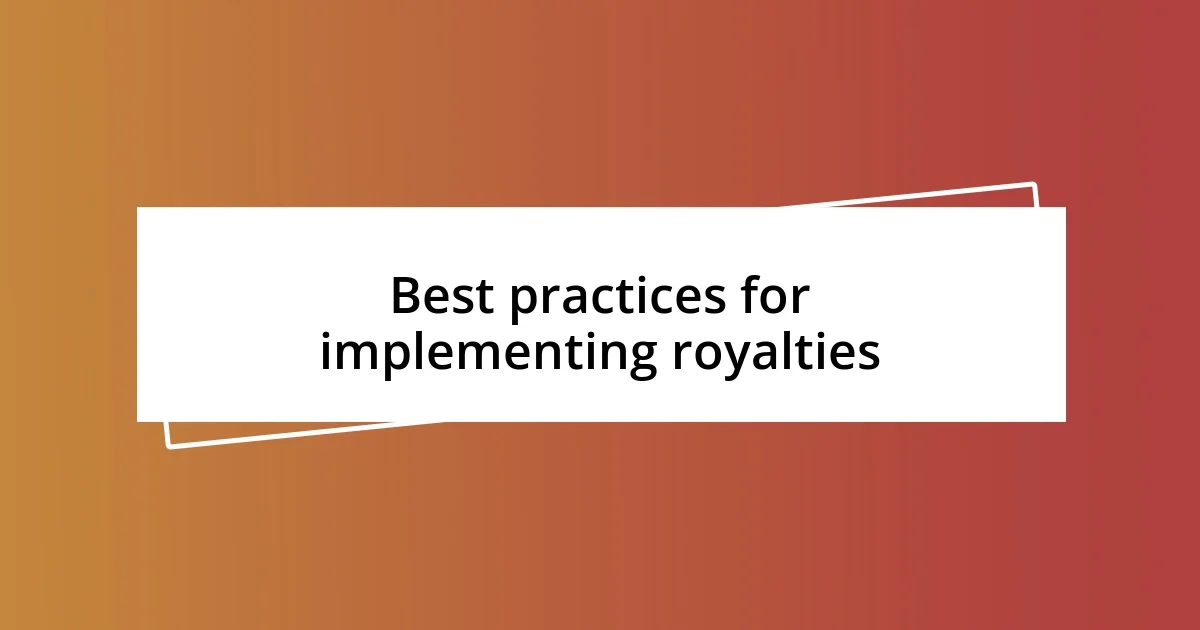
Best practices for implementing royalties
Implementing royalties effectively requires clarity and communication with both collectors and platforms. From my own experience, setting transparent expectations in your NFT listings can significantly reduce misunderstandings. I recall a time when I clearly outlined my royalty expectations, leading to more respectful conversations with potential buyers— enlightening the importance of knowing what to advocate for.
Choosing a platform that prioritizes royalty payment enforcement is crucial. I’ve personally tested various marketplaces, and it’s become evident that some truly honor the creators’ rights, while others take a more laissez-faire attitude. Have you ever been let down by a platform that claimed to support artists but fell short? The sense of betrayal I felt really hit home when I realized how critical it is to do your research beforehand.
Finally, it’s important to educate your audience about the value of royalties. I found that when collectors understand how their purchase supports artists like me, they’re often more willing to respect those fees. Sharing stories about how royalty income has impacted my creative journey helped foster a deeper connection with my audience, enriching the experience for everyone involved. It’s fascinating how raising awareness can transform not just transactions, but the entire collector-artist relationship.
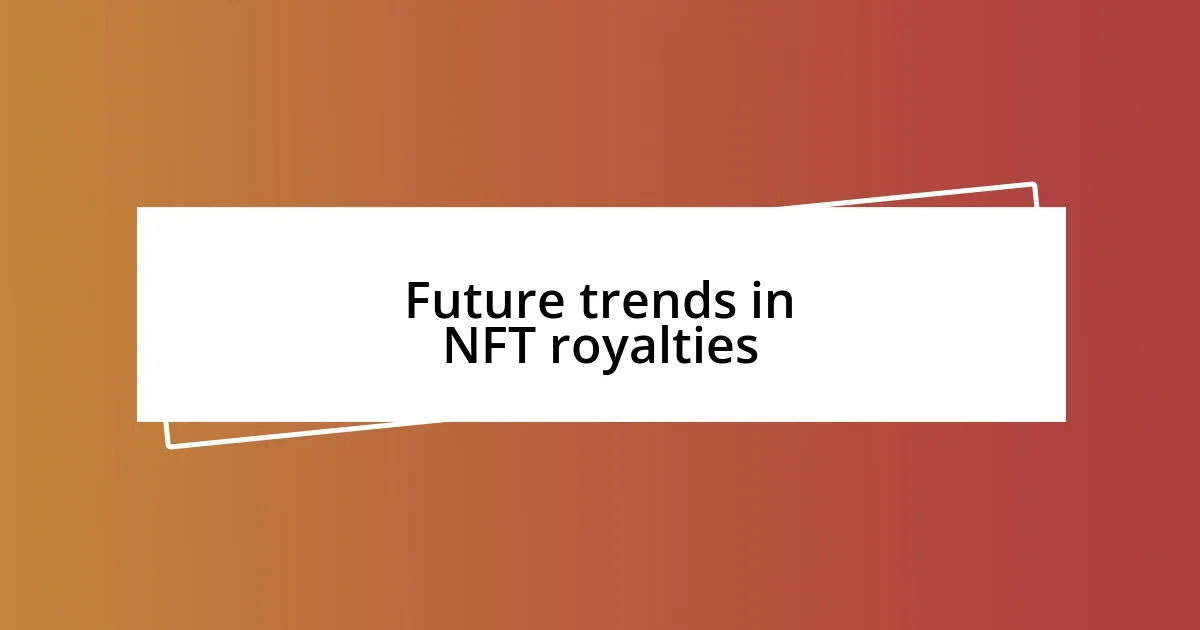
Future trends in NFT royalties
The future of NFT royalties is evolving rapidly, and I believe we are on the brink of significant change. As more artists share their perspectives, platforms will likely begin to prioritize transparent and standardized royalty practices. I recall attending a virtual panel where artists voiced their frustrations about inconsistent payments, and it was heartening to see collective ideas brewing on how we could push for reforms collaboratively. Isn’t it exciting to think that by uniting our voices, we can influence the marketplace for the better?
I also see emerging trends around programmable royalties, which allow creators to define terms linked to secondary sales automatically. This technology could ensure that artists continuously benefit each time their work changes hands. Personally, I can’t help but think about how empowering this could be for all creators, especially those just starting. Have you ever dreamt of a system where your artwork’s value appreciates over time, and you still receive a slice of the pie? That’s a vision worth striving for, and I believe it’s becoming more achievable.
Lastly, the conversation around royalties is expanding beyond just financial compensation. Many artists, myself included, are beginning to advocate for royalties as a form of recognition and respect for our craft. It’s not merely about the money; it’s about establishing a culture that values and honors creativity. When I share this mindset with fellow creators, I often see a spark of agreement in their eyes. Wouldn’t it be refreshing if the conversation shifted to how royalties validate our work rather than just being a transactional discussion?
